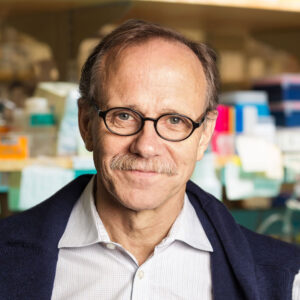Fred H. Gage, PhD
Address:
Adler Professor
Laboratory of Genetics
Vi and John Adler Chair for Research on Age-Related Neurodegenerative Disease
The Salk Institute for Biological Studies
- Lab:
- Gage Lab
- Salk Institute for Biological Studies
- Profile: Rusty Gage, PhD

Novelty seeking behavior and engram cells
To study genetic and age-related risk factors in a human age-equivalent, adult-like, and patient-specific neuronal model system, induced neurons (iNs) directly converted from primary human fibroblasts offer unique possibilities to model and study Aging and Alzheimer’s Disease (AD). We and others have previously demonstrated that elderly human donor-derived iNs mirror transcriptomic signatures of brain aging, show impaired nuclear pore sub-cellular transport, and metabolic and mitochondrial aging defects, and other functional signatures of aging, and mirror the epigenetic clock ages of their donors. iNs globally reflect the major risk factor for the development of neurodegenerative disorders, and stand out as a unique and complementary model system to animal and iPSC-based models. Our iN cultures comprise a major fraction of ˜80% excitatory glutamatergic neurons, and a minor fraction of inhibitory neurons and their transcriptomes map to adult human cortical tissue, and endogenously show adult MAPT splicing and tau protein isoform expression including 2N and 4R, which is altered in iNs from tauopathy patients. We have employed direct conversion of AD patient fibroblasts into iNs to generate an age-equivalent neuronal model for late-onset sAD, which exhibited neuronal transcriptome signatures that showed a high level of concordance to post-mortem AD patient bulk and single cell transcriptome data, including the ROSMAP data base. We also generated rejuvenated iPSC-derived neurons from the same mostly sporadic patient cohort, which however showed no significant disease-related signatures. iNs thus provide an attractive disease modeling platform complementary to iPSCs and that offers the unique advantage of displaying age-dependent sporadic AD phenotypes in addition to genetic features. Indeed, AD iNs reflected a hypo-mature neuronal identity, display elevated levels of DNA damage stress, early cell cycle markers without cell division, markers for re-entry into glycolysis, phenotypic neuronal de-differentiation, and senescence-associate secretion of pro-inflammatory factors. Together, these data suggest that AD is a highly multifactorial disease, in which neurons are not merely damaged from the outside but commit to activating a malignant cellular program of fate-loss and vulnerability.
Dr. Gage is the Adler Professor in the Laboratory of Genetics, Adjunct Professor, UCSD and immediate past President of the Salk Institute. He received his Ph.D. from The Johns Hopkins University. Dr. Gage’s work concentrates on the adult central nervous system and unexpected plasticity and adaptability to environmental stimulation that remains throughout the life of all mammals. In addition, he models human neurological and psychiatric disease in vitro using human stem cells. His lab also studies the genomic mosaicism that exists in the brain as a result of mobile elements that are active during neurogenesis.
Dr. Gage is a Fellow of the AAAS, a Member of the National Academy of Sciences and the National Academy of Medicine, and American Philosophical Society, a foreign member of the EMBO and a Member of the American Academy of Arts and Sciences. He served as President of the Society for Neuroscience in 2002, and of the International Society for Stem Cell Research in 2012.
Reading List
Herdy, Joseph R., Jerome Mertens, et al. “Neuronal senescence may drive brain aging.” Science, vol. 384, no. 6703, 28 June 2024, pp. 1404–1406, https://doi.org/10.1126/science.adi3450.
Herdy, Joseph R., Larissa Traxler, et al. “Increased post-mitotic senescence in aged human neurons is a pathological feature of alzheimer’s disease.” Cell Stem Cell, vol. 29, no. 12, Dec. 2022, https://doi.org/10.1016/j.stem.2022.11.010.
Mertens, Jerome, et al. “Age-dependent instability of mature neuronal fate in induced neurons from alzheimer’s patients.” Cell Stem Cell, vol. 28, no. 9, Sept. 2021, https://doi.org/10.1016/j.stem.2021.04.004.
Parylak, Sarah L., et al. “Neuronal activity‐related transcription is blunted in immature compared to mature dentate granule cells.” Hippocampus, vol. 33, no. 4, 22 Feb. 2023, pp. 412–423, https://doi.org/10.1002/hipo.23515.
Traxler, Larissa, et al. “Warburg-like metabolic transformation underlies neuronal degeneration in sporadic alzheimer’s disease.” Cell Metabolism, vol. 34, no. 9, Sept. 2022, https://doi.org/10.1016/j.cmet.2022.07.014.